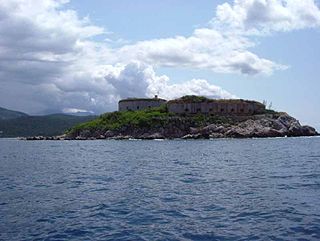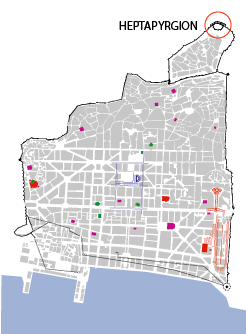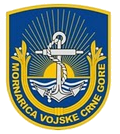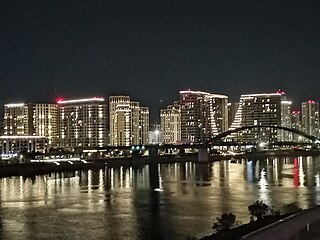
Kanli Kula is a fortress with an open-air amphitheater in Herceg Novi, Montenegro. The name is of Turkish origin, and means "bloody tower".

Kanli Kula is a fortress with an open-air amphitheater in Herceg Novi, Montenegro. The name is of Turkish origin, and means "bloody tower".
Kanli Kula was built by the Turks [1] in 1539. The Venetians made various repairs and additions in 1687, soon after conquering Herceg Novi. [2]

Inside the castle there was a well preserved water cistern. At some stage it lost its original purpose and became a prison, and was thereafter called “Bloody Tower“. The inmates left multiple drawings on the walls of the prison. The depicted ships were in service in 16th and 17th centuries, which allowed historians to date the founding of the prison. [3]
The inside of the Kanli Tower was restored into an open-air amphitheater in 1966. It seats over 1000 spectators, and has hosted many cultural events and festivals. [4] Events that are organised in Kanli Kula have included the Herceg Novi Film Festival, Guitar Art Summer Fest and the Operosa Montenegro Opera Festival. [5]

The Bay of Kotor, also known as the Boka, is a winding bay of the Adriatic Sea in southwestern Montenegro and the region of Montenegro concentrated around the bay. It is also the southernmost part of the historical region of Dalmatia. The bay has been inhabited since antiquity. Its well-preserved medieval towns of Kotor, Risan, Tivat, Perast, Prčanj and Herceg Novi, along with their natural surroundings, are major tourist attractions. The Natural and Culturo-Historical Region of Kotor was designated a UNESCO World Heritage Site in 1979. Its numerous Orthodox and Catholic churches and monasteries attract numerous religious pilgrims and other visitors.

Herceg Novi is a coastal town in Montenegro located at the Western entrance to the Bay of Kotor and at the foot of Mount Orjen. It is the administrative center of the Herceg Novi Municipality with around 33,000 inhabitants. The town was founded as a fortress in 1382 by the King of Bosnia, Tvrtko I Kotromanić, and named after Saint Stephen but the name did not stick, instead it became known as Novi (transl. New), also Castelnuovo in Italian. Between 1482 and 1687 it was part of the Ottoman Empire and then from 1687 to 1797 the Albania Veneta of the Republic of Venice. It was a Catholic bishopric and remains a Latin titular see as Novi. Herceg Novi has had a turbulent past, despite being one of the youngest settlements on the Adriatic. A history of varied occupations has created a blend of diverse and picturesque architectural style in the city.

Risan is a town in the Bay of Kotor, Montenegro. It traces its origins to the ancient settlement of Rhizon, the oldest settlement in the Bay of Kotor.

Kolašin is a town in northern Montenegro. It has a population of 2,989. Kolašin is the centre of Kolašin Municipality and an unofficial centre of Morača region, named after Morača River.

Herceg Novi Municipality is one of the municipalities in southwestern Montenegro region. The administrative center is Herceg Novi.

Mamula, also known colloquially as Lastavica, is an uninhabited islet in the Adriatic Sea, within the southwestern Montenegrin municipality of Herceg Novi.
Montenegro is one of the fastest-growing tourist destinations. In 2007, over a million tourists visited Montenegro, making some 7.3 million overnight stays. This accounted for some 480 million euros in tourism revenue in 2007. In 2015, tourism realised over 1.7 million arrivals, with a further increase in 2016. In the same year, the coastal town of Kotor was named the best city to visit by Lonely Planet, whereas the country itself is continuously included in touristic top lists. With a total of 1.8 million visitors in 2016, the nation became the 36th most popular country to travel to in Europe. Montenegro was further visited by over 2 million tourists in 2017. The Government aims to attract greenfield investments, which should make best use of undeveloped parts of the coast, such as Jaz Beach, Velika Plaža, Ada Bojana and Buljarica.

The Heptapyrgion, modern Eptapyrgio, also popularly known by its Ottoman Turkish name Yedi Kule, is a Byzantine and Ottoman-era fortress situated on the north-eastern corner of the Acropolis of Thessaloniki in Greece. Despite its name, which in both languages means "Fortress of Seven Towers", it features ten, and was probably named after the Yedikule Fortress in Constantinople. It served as the major redoubt of the city's acropolis, as well as the seat of its garrison commander in Ottoman times, until the late 19th century. It was then converted to a prison, which remained open until 1989. References to the infamous Yedi Kule prison abound in the Greek rebetika songs. Restoration and archaeological work began in the 1970s and continues to this day.

Vushtrri Castle or Old Tower is a city fortifications in Vushtrri, Kosovo. It was the seat of despot Đurađ Branković (1427–1456). Later chroniclers are noted that the fort itself is derived from the times of Dušan, and that it is an old fortress with a tower in the middle of the town.

The Montenegrin Navy is the naval branch of the military of Montenegro.

The Clock Tower of Podgorica, Montenegro, is located at Bećir Beg Osmanagić square, in the Stara Varoš neighborhood. It is one of the very few Ottoman landmarks that survived the bombing of Podgorica in World War II.

Ivan kula is a fortress of Ivan Kosančić, located 33 km south of town Kuršumlija, Serbia, on the mountain Radan. The fort is located on a separate top 1076 m. near the village of Ivan Kula, southwest tip of Đak.

Belgrade Waterfront, known in Serbian as Belgrade on Water, is an urban renewal development project headed by the Government of Serbia aimed at improving Belgrade's cityscape and economy by revitalizing the Sava amphitheater, a neglected stretch of land on the right bank of the Sava river, between the Belgrade Fair and Branko's bridge. It was started in 2014 with the reconstruction of the Belgrade Cooperative building, which was finished in June of the same year. It is the second largest mixed use complex under construction in Europe, just after Minsk Mir, worth $3.5 billion. Belgrade Waterfront complex will include 10,000 residential units, bilingual elementary school and kindergartens, luxury hotels including St. Regis, the largest shopping mall in southeast Europe Galerija, and public buildings. In total, about 1.8 million square meters will be built.

Operosa is an annual classical music and opera festival. Devoted mainly to opera, it also includes concerts of orchestral, chamber, vocal and solo instrumental music. Operosa is active in the Balkan region with the main festival event in Herceg Novi in Montenegro.

Belgrade Tower, officially known as Kula Belgrade, is a 42-floor, 168-meter (551 ft) tall mixed-use skyscraper currently under construction in the Belgrade Waterfront project in Belgrade, Serbia.
Lazaret Meljine is a fortress and a military hospital built by the Venetians in 1732 near the town of Herceg Novi (Montenegro) in the village of Meljine on the beach. This institution performed quarantine functions, and also gave permission for the import or export of various products. Lazaret survived to this day.

Katherine Elina Haataja is a Finnish-Swedish mezzo-soprano and entrepreneur, known for her work advocating for young opera artists. She is a descendant of the Hannikainen family of composers and writers, Pietari Hannikainen was her third great grandfather.

Music & More SummerFest is a two-week annual international festival of classical and contemporary music, held in Trebinje, Bosnia & Herzegovina, in the first half of August. It was founded in 2018 by the pianist and educator Dr. Tatjana Rankovich, who also directs the festival.